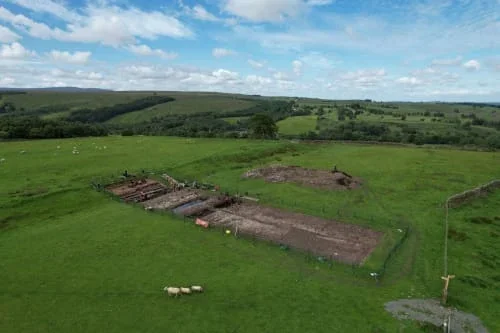Archaeologists have unearthed dozens of Roman-era footwear at an ancient fort site in northern England, including several giant leather shoes measuring nearly 12 inches, raising questions about their wearers.
The find at the Magna Roman Fort near Carvoran in Northumberland reveal fresh insights about the lifestyle of people who lived in the region nearly 2,000 years ago.
Excavations began at the ancient fort’s northern defensive ditches with some of the first 32 shoes uncovered seeming very large.
A 32 cm leather shoe sole unearthed by the archaeologists gained attention and with further excavation of ancient shoes, several more were found to be of exceptional size.
Eight ancient shoes from the site have so far been recorded as “XX-Large” 30 cm or over in length, with one at at 32.6cm long (modern UK size 14/US size 16) deemed the largest uncovered so far.
“There is much more to discover about the people who lived at Magna and to understand about the impact climate change is having on this hugely important historical resource,” said Rachel Frame, senior archaeologist at the project.
“Organic finds like this are some of the most precious to come from our sites, which capture the imagination of visitors and volunteers alike, but they are also the most at risk from our changing climate,” Dr Frame warned.
Archaeologists also found shoes of a range of other sizes, including those belonging to children.
In comparison overall, the average size of shoes found at the ancient site is about 24-26cm in length, researchers say.
“I think there is something very different going on here at Magna, even from this small sample uncovered it is clear that these shoes are much larger on average than most of the Vindolanda collection,” said archaeologist Elizabeth Greene from the University of Western Ontario.
“Even taking into account a maximum shrinkage of up to 1cm or 10mm, it still means these shoes are very large indeed,” Dr Greene said.

Researchers say shoes found at the site are unique, with each one providing insights into the Roman-era person who wore it.
“It reminds us that not every population was the same, that wide variations between the regiments and people who served along Hadrian’s Wall could be cultural and physical,” said Andrew Birley, director of excavations at the Vindolanda Charitable Trust.
“We can only celebrate and marvel at the diversity and differences of these people if we can still see them in the archaeological data we gather today,” he added.
Ukraine war latest: Deputy head of Russian Navy killed in Ukrainian attack on Kursk
Mystery over ‘unusually large’ Roman shoes unearthed
Businesses ‘thriving’ after adopting four-day working week
Secrets of ancient societies revealed through DNA from 4,000-year-old teeth
Researchers reveal what Ancient Rome smelled like – and it’s disgusting
Dentist cracks centuries-old puzzle hidden in famous Da Vinci drawing







